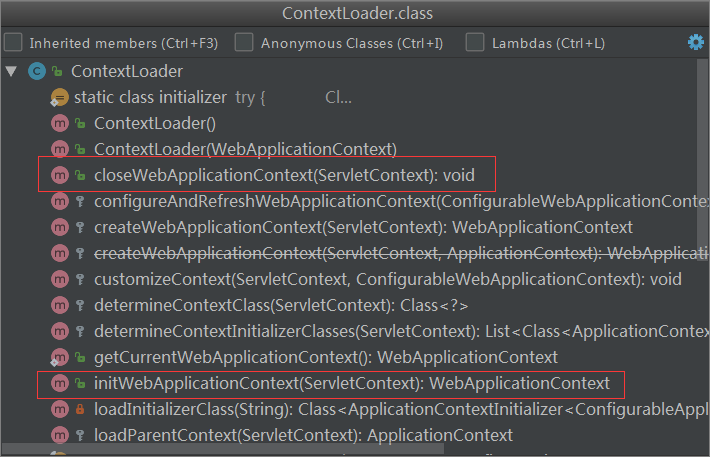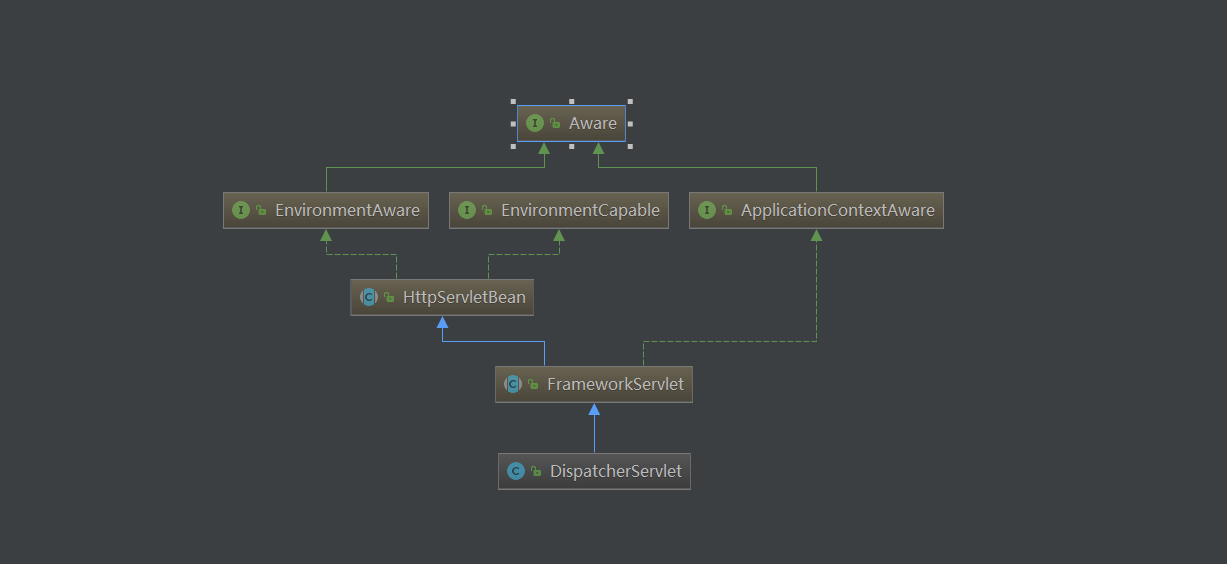Web容器初始化过程
一、SpringMVC启动过程
Spring的MVC是基于Servlet功能实现的,每个web工程中都有一个web.xml文件,web容器在启动的时候会加载这个配置文件,当一个web应用加载到web容器中后,在web应用开始响应客户端的请求之前,要按照顺序执行下面几个步骤:
1、实例化部署描述符中的<listener>元素标识的时间监听器的实例;
<listener>
<listener-class>org.springframework.web.context.ContextLoaderListener</listener-class>
</listener>
2、在实现了ServletContextListener接口的监听器实例中,调用contextInitialized()方法。ContextLoaderListener实现了ServletContextListener接口,ServletContextListener作为Servlet的监听者,会在ServletContext创建、销毁过程中监听ServletContextEvent事件,然后进行响应的处理。换句话说,就是在启动web容器时,ContextLoaderListener类会自动装配ApplicationContext的配置信息。
public class ContextLoaderListener extends ContextLoader implements ServletContextListener {
public ContextLoaderListener() {
}
public ContextLoaderListener(WebApplicationContext context) {
super(context);
}
// 这里调用其父类ContextLoader的initWebApplicationContext进行初始化工作
public void contextInitialized(ServletContextEvent event) {
this.initWebApplicationContext(event.getServletContext());
}
public void contextDestroyed(ServletContextEvent event) {
this.closeWebApplicationContext(event.getServletContext());
ContextCleanupListener.cleanupAttributes(event.getServletContext());
}
}
ContextLoaderListener类继承了ContextLoader,后者是实际的ServletContextListener接口实现者,这里用到了代理模式,利用ContextLoader类创建Spring application context,并将其注册到ServletContext中去。ContextLoaderListener就是调用ContextLoader类的initWebApplicationContext()方法和closeWebApplicationContext()方法来实现ServletContext的创建和销毁工作的。

其中,initWebApplicationContext()方法主要完成了两个部分的工作:一是查看是否已经指定父容器,如果不存在则设置其父容器。二是将Spring WebApplicationContext放置到线程Map中。
public WebApplicationContext initWebApplicationContext(ServletContext servletContext) {
if (servletContext.getAttribute(WebApplicationContext.ROOT_WEB_APPLICATION_CONTEXT_ATTRIBUTE) != null) {
throw new IllegalStateException("Cannot initialize context because there is already a root application context present - check whether you have multiple ContextLoader* definitions in your web.xml!");
} else {
Log logger = LogFactory.getLog(ContextLoader.class);
servletContext.log("Initializing Spring root WebApplicationContext");
if (logger.isInfoEnabled()) {
logger.info("Root WebApplicationContext: initialization started");
}
long startTime = System.currentTimeMillis();
try {
if (this.context == null) {
this.context = this.createWebApplicationContext(servletContext);
}
if (this.context instanceof ConfigurableWebApplicationContext) {
ConfigurableWebApplicationContext cwac = (ConfigurableWebApplicationContext)this.context;
if (!cwac.isActive()) {
//查看是否指定父容器
if (cwac.getParent() == null) {
ApplicationContext parent = this.loadParentContext(servletContext);
cwac.setParent(parent);
}
this.configureAndRefreshWebApplicationContext(cwac, servletContext);
}
}
servletContext.setAttribute(WebApplicationContext.ROOT_WEB_APPLICATION_CONTEXT_ATTRIBUTE, this.context);
ClassLoader ccl = Thread.currentThread().getContextClassLoader();
//将WebApplicationContext放置到线程Map中
if (ccl == ContextLoader.class.getClassLoader()) {
currentContext = this.context;
} else if (ccl != null) {
currentContextPerThread.put(ccl, this.context);
}
if (logger.isDebugEnabled()) {
logger.debug("Published root WebApplicationContext as ServletContext attribute with name [" + WebApplicationContext.ROOT_WEB_APPLICATION_CONTEXT_ATTRIBUTE + "]");
}
if (logger.isInfoEnabled()) {
long elapsedTime = System.currentTimeMillis() - startTime;
logger.info("Root WebApplicationContext: initialization completed in " + elapsedTime + " ms");
}
return this.context;
} catch (RuntimeException var8) {
logger.error("Context initialization failed", var8);
servletContext.setAttribute(WebApplicationContext.ROOT_WEB_APPLICATION_CONTEXT_ATTRIBUTE, var8);
throw var8;
} catch (Error var9) {
logger.error("Context initialization failed", var9);
servletContext.setAttribute(WebApplicationContext.ROOT_WEB_APPLICATION_CONTEXT_ATTRIBUTE, var9);
throw var9;
}
}
}
在初始化方法执行后,将WebApplicationContext存到了两个地方,分别是ServletContext和currentContextPerThread中,我们可以通过这两个地方来获取WebApplicationContext:1.从servletContext中去拿;2.从当前的线程Map中去拿。
3、实例化部署符中<filter>元素标识的过滤器实例,并调用每个过滤器实例的init()方法。
4、实例化部署符中<servlet>元素标识的Servlet实例,按照该元素包含的load-on-startup顺序,调用每个Servlet实例的init()方法。
<servlet-class>org.springframework.web.servlet.DispatcherServlet</servlet-class>
在SpringMVC的架构中,DispatcherServlet主要负责客户端请求的分发,起到控制器的作用。DispatcherServlet是实现Servlet接口的实现类,其结构如下图所示。Servlet的生命周期由Servlet的容器来控制,主要分为初始化、运行和销毁三个阶段,分别对应三个方法:init()、service()和destory()。

在DispatcherServlet的父类HTTPServletBean中,重写了init()方法,主要实现将当前的Servlet类实例转换为BeanWrapper类型实例,以便使用Spring中提供的注入功能进行相应属性的注入。
在DispatcherServlet的父类FameworkServelet中,重写了service()方法,对于不同的方法,Spring统一将程序引导至processRequest(request,response)中,processRequest方法再对处理请求进行了一些准备工作后,又将细节实现转移到了doService方法中。
protected void service(HttpServletRequest request, HttpServletResponse response) throws ServletException, IOException {
String method = request.getMethod();
if (method.equalsIgnoreCase(RequestMethod.PATCH.name())) {
this.processRequest(request, response);
} else {
super.service(request, response);
}
}
protected final void processRequest(HttpServletRequest request, HttpServletResponse response) throws ServletException, IOException {
long startTime = System.currentTimeMillis();
Throwable failureCause = null;
LocaleContext previousLocaleContext = LocaleContextHolder.getLocaleContext();
LocaleContext localeContext = this.buildLocaleContext(request);
RequestAttributes previousAttributes = RequestContextHolder.getRequestAttributes();
ServletRequestAttributes requestAttributes = this.buildRequestAttributes(request, response, previousAttributes);
WebAsyncManager asyncManager = WebAsyncUtils.getAsyncManager(request);
asyncManager.registerCallableInterceptor(FrameworkServlet.class.getName(), new FrameworkServlet.RequestBindingInterceptor());
this.initContextHolders(request, localeContext, requestAttributes);
try {
//调用DispatcherServlet的doService()方法
this.doService(request, response);
} catch (ServletException var17) {
failureCause = var17;
throw var17;
} catch (IOException var18) {
failureCause = var18;
throw var18;
} catch (Throwable var19) {
failureCause = var19;
throw new NestedServletException("Request processing failed", var19);
} finally {
this.resetContextHolders(request, previousLocaleContext, previousAttributes);
if (requestAttributes != null) {
requestAttributes.requestCompleted();
}
if (this.logger.isDebugEnabled()) {
if (failureCause != null) {
this.logger.debug("Could not complete request", (Throwable)failureCause);
} else if (asyncManager.isConcurrentHandlingStarted()) {
this.logger.debug("Leaving response open for concurrent processing");
} else {
this.logger.debug("Successfully completed request");
}
}
this.publishRequestHandledEvent(request, response, startTime, (Throwable)failureCause);
}
}
protected void doService(HttpServletRequest request, HttpServletResponse response) throws Exception {
if (this.logger.isDebugEnabled()) {
String resumed = WebAsyncUtils.getAsyncManager(request).hasConcurrentResult() ? " resumed" : "";
this.logger.debug("DispatcherServlet with name '" + this.getServletName() + "'" + resumed + " processing " + request.getMethod() + " request for [" + getRequestUri(request) + "]");
}
Map<String, Object> attributesSnapshot = null;
if (WebUtils.isIncludeRequest(request)) {
attributesSnapshot = new HashMap();
Enumeration attrNames = request.getAttributeNames();
label108:
while(true) {
String attrName;
do {
if (!attrNames.hasMoreElements()) {
break label108;
}
attrName = (String)attrNames.nextElement();
} while(!this.cleanupAfterInclude && !attrName.startsWith("org.springframework.web.servlet"));
attributesSnapshot.put(attrName, request.getAttribute(attrName));
}
}
request.setAttribute(WEB_APPLICATION_CONTEXT_ATTRIBUTE, this.getWebApplicationContext());
request.setAttribute(LOCALE_RESOLVER_ATTRIBUTE, this.localeResolver);
request.setAttribute(THEME_RESOLVER_ATTRIBUTE, this.themeResolver);
request.setAttribute(THEME_SOURCE_ATTRIBUTE, this.getThemeSource());
FlashMap inputFlashMap = this.flashMapManager.retrieveAndUpdate(request, response);
if (inputFlashMap != null) {
request.setAttribute(INPUT_FLASH_MAP_ATTRIBUTE, Collections.unmodifiableMap(inputFlashMap));
}
request.setAttribute(OUTPUT_FLASH_MAP_ATTRIBUTE, new FlashMap());
request.setAttribute(FLASH_MAP_MANAGER_ATTRIBUTE, this.flashMapManager);
try {
// 最终的请求处理函数
this.doDispatch(request, response);
} finally {
if (!WebAsyncUtils.getAsyncManager(request).isConcurrentHandlingStarted() && attributesSnapshot != null) {
this.restoreAttributesAfterInclude(request, attributesSnapshot);
}
}
}
经过层层的准备工作,最终在doDispatch()方法中实现了完整的请求处理过程:
protected void doDispatch(HttpServletRequest request, HttpServletResponse response) throws Exception {
HttpServletRequest processedRequest = request;
HandlerExecutionChain mappedHandler = null;
boolean multipartRequestParsed = false;
WebAsyncManager asyncManager = WebAsyncUtils.getAsyncManager(request);
try {
try {
ModelAndView mv = null;
Exception dispatchException = null;
try {
processedRequest = this.checkMultipart(request);
multipartRequestParsed = processedRequest != request;
//根据request信息寻找对应的处理器
mappedHandler = this.getHandler(processedRequest);
if (mappedHandler == null || mappedHandler.getHandler() == null) {
this.noHandlerFound(processedRequest, response);
return;
}
//根据处理器寻找对应的处理器适配器
HandlerAdapter ha = this.getHandlerAdapter(mappedHandler.getHandler());
String method = request.getMethod();
boolean isGet = "GET".equals(method);
if (isGet || "HEAD".equals(method)) {
long lastModified = ha.getLastModified(request, mappedHandler.getHandler());
if (this.logger.isDebugEnabled()) {
this.logger.debug("Last-Modified value for [" + getRequestUri(request) + "] is: " + lastModified);
}
if ((new ServletWebRequest(request, response)).checkNotModified(lastModified) && isGet) {
return;
}
}
if (!mappedHandler.applyPreHandle(processedRequest, response)) {
return;
}
//返回视图
mv = ha.handle(processedRequest, response, mappedHandler.getHandler());
if (asyncManager.isConcurrentHandlingStarted()) {
return;
}
this.applyDefaultViewName(request, mv);
mappedHandler.applyPostHandle(processedRequest, response, mv);
} catch (Exception var19) {
dispatchException = var19;
}
this.processDispatchResult(processedRequest, response, mappedHandler, mv, dispatchException);
} catch (Exception var20) {
this.triggerAfterCompletion(processedRequest, response, mappedHandler, var20);
} catch (Error var21) {
this.triggerAfterCompletionWithError(processedRequest, response, mappedHandler, var21);
}
} finally {
if (asyncManager.isConcurrentHandlingStarted()) {
if (mappedHandler != null) {
mappedHandler.applyAfterConcurrentHandlingStarted(processedRequest, response);
}
} else if (multipartRequestParsed) {
this.cleanupMultipart(processedRequest);
}
}
}
二、ServletContext、ApplicationContext和WebApplicationContext区别?
1、ServletContext:是一个Web应用的上下文,是一个全局信息的存储空间,代表当前的web应用。Servlet容器(如Tomcat)在启动一个Webapp时,会为它创建一个ServletContext对象,即servlet上下文环境。每个webapp都有唯一的ServletContext对象。同一个webapp的所有servlet对象共享一个ServeltContext,servlet对象可以通过ServletContext来访问容器中的各种资源。ServletContext在web应用启动时创建,在web应用服务关闭时释放。
2、ApplicationContext:它是建立在BeanFactory基础之上的,除了包含BeanFactory的所有功能之外,在国际化支持、资源访问、事件传播等方面进行了良好的支持。其体系结构如下图。

ApplicationContext接口有三个常用的实现类,如下:
| 类名称 | 功能描述 |
| ClassPathXmlApplicationContext |
从类路径ClassPath中寻找指定的XML配置文件,找到并装载
完成ApplicationContext的实例化工作
|
| FileSystemXmlApplicationContext |
从指定的文件系统路径中寻找指定的XML配置文件,找到并装载
完成ApplicationContext的实例化工作
|
| XmlWebApplicationContext | 从Web应用中寻找指定的XML配置文件,找到并装载完成ApplicationContext的实例化工作 |
与BeanFactory不同的是,ApplicationContext容器实例化后会自动对所有的单实例Bean进行实例化与依赖关系的装配,使之处于待用状态。而BeanFactory容器实例化后并不会自动实例化Bean,只有当Bean被使用时BeanFactory容器才会对该Bean进行实例化与依赖关系的装配。
3、WebApplicationContext:它是专门为web应用提供的,它允许从相对于web根目录路径中装载配置文件完成初始化;从WebApplicationContext中可以获得ServletContext的引用,同时为了方便web应用访问Spring应用上下文,WebApplicationContext也将作为一个属性放到ServletContext中,可以通过WebApplicationContextUtils的getWebApplicationContext(ServletContext sc)方法获取。

三、总结
ApplicationContext是Spring的核心,Context为上下文环境,在Web应用中,会用到WebApplicationContext,它继承自ApplicationContext。在SpringMVC启动过程中,ContextLoaderListener类起着至关重要的作用。它读取web.xml中配置的context-param中的配置文件,提前在web容器初始化前准备业务对应的Application context,将创建好的WebApplicationContext放置于ServletContext属性中,这样我们只要得到Servlet就可以得到WebApplicationContext对象,并利用这个对象访问spring容器管理的bean。
四、参考资料
1、https://www.cnblogs.com/RunForLove/p/5688731.html
Web容器初始化过程的更多相关文章
- Spring源码解析-Web容器启动过程
Web容器启动过程,主要讲解Servlet和Spring容器结合的内容. 流程图如下: Web容器启动的Root Context是有ContextLoaderListener,一般使用spring,都 ...
- Spring源码-IOC部分-容器初始化过程【2】
实验环境:spring-framework-5.0.2.jdk8.gradle4.3.1 Spring源码-IOC部分-容器简介[1] Spring源码-IOC部分-容器初始化过程[2] Spring ...
- Spring IoC容器初始化过程学习
IoC容器是什么?IoC文英全称Inversion of Control,即控制反转,我么可以这么理解IoC容器: 把某些业务对象的的控制权交给一个平台或者框架来同一管理,这个同一管理的平台可以称为I ...
- Web项目初始化过程
在启动Web项目时,容器(比如Tomcat)会读web.xml配置文件中的两个节点<listener>和<contex-param>. 接着容器会创建一个ServletCont ...
- spring源码学习之路---深度分析IOC容器初始化过程(四)
作者:zuoxiaolong8810(左潇龙),转载请注明出处,特别说明:本博文来自博主原博客,为保证新博客中博文的完整性,特复制到此留存,如需转载请注明新博客地址即可. 最近由于工作和生活,学习耽搁 ...
- Spring之IOC容器初始化过程
Ioc容器的初始化是由refresh()方法来启动的,这个方法标志着Ioc容器的正式启动. 具体来说这个启动过程包括三个基本过程: 1.BeanDifinition的Resource定位 2.Bean ...
- Spring源码解析二:IOC容器初始化过程详解
IOC容器初始化分为三个步骤,分别是: 1.Resource定位,即BeanDefinition的资源定位. 2.BeanDefinition的载入 3.向IOC容器注册BeanDefinition ...
- Spring Ioc 容器初始化过程
IOC 是如何工作的? 通过 ApplicationContext 创建 Spring 容器,容器读取配置文件 "/beans.xml" 并管理定义的 Bean 实例对象. 通 ...
- Spring Boot IoC 容器初始化过程
1. 加载 ApplicationContextInializer & ApplicationListener 2. 初始化环境 ConfigurableEnvironment & 加 ...
随机推荐
- jdk各种包安装方式
大家都知道,现在JAVA的发展可谓是如日中天,它覆盖面非常广泛,小到个人PC,大到商业应用都能见到它的身影.以前它是由SUN公司来维护的,现在已经归属到甲骨文旗下了. 今天我们来学习一下Java JD ...
- javascript对属性的操作
<!DOCTYPE html> <html> <head> <meta charset="UTF-8"> <title> ...
- .NET开源Protobuf-net组件修炼手册
一.前言 Protocol Buffer(简称Protobuf或PB) 是一个跨平台的消息交互协议,类似xml.json等 :别只会用Json和XML了,快来看看Google出品的Protocol B ...
- Linux目录/usr缩写及目录结构说明
在 linux 文件结构中,有一个很神奇的目录 —— /usr. 讨论中,大部分观点认为: usr 是 unix system resources 的缩写: usr 是 user 的缩写: u ...
- C# CancellationTokenSource和CancellationToken的实现
微软关于CancellationTokenSource的介绍很简单,其实CancellationTokenSource的使用也很简单,但是实现就不是那么简单了,我们首先来看看CancellationT ...
- 使用python实现深度神经网络 1(转)
使用python实现深度神经网络 1(转) https://blog.csdn.net/oxuzhenyi/article/details/73026790
- ld: framework not found FileProvider for architecture arm64
出现这个问题是因为 静态库是用Xcode9打包的. 如果用xcode8编译的话就会出现这个问题 解决办法 从Xcode9里把这个库拷贝出来.然后放到Xcode8上面 One way to fix t ...
- WPF 实现窗体拖动
C# 实现代码 this.Loaded += (r, s) => { this.MouseDown += (x, y) => { if (y.LeftButton == MouseButt ...
- [Python设计模式] 第19章 分公司=部门?——组合模式
github地址:https://github.com/cheesezh/python_design_patterns 组合模式 组合模式,将对象组合成树形结构以表示"部分-整体" ...
- .Net混淆工具和反混淆工具
一.简介 本文给大家列举一些常用的.net程序反破解代码混淆工具.同时也列取一些反混淆工具. 二.混淆工具 Agile.NET (aka CliSecure) Babel.NET CodeFort C ...
